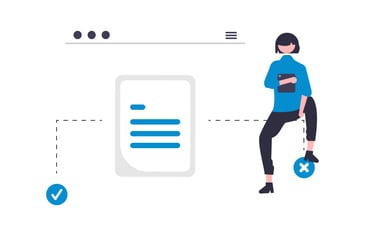What are customer feedback tools?
The right tools make it easy to connect with your customers and identify their needs. But how can you decide which strategy and channel are right for your business?
From the latest customer experience data to trends in gathering customer feedback our blog hosts the latest articles on a wide range of CX topics.

The right tools make it easy to connect with your customers and identify their needs. But how can you decide which strategy and channel are right for your business?

In today's digital age, online reviews have become a core part of any business' reputation management.

Customer feedback is vital because without knowing what to improve, you can’t make effective changes. But what can you do when a feedback survey doesn’t get the volume of responses you expect?

When it comes to implementing a customer feedback strategy, brands want to know how many responses they are going to get – we understand! You don’t want to waste time and resources on a survey only to find your customers aren’t willing to respond.

Without a problem, there’s no need for a solution. Unfortunately, that means your sales team may struggle to convert leads and generate growth. So how can you make sure your time spent with prospects is successful? It all comes down to pain points.

It’s common for businesses to avoid customer feedback simply because they don’t know what to do with it. However, this means they miss out on a valuable opportunity to grow.

For many businesses, Facebook reviews are bittersweet. Customer review platforms provide transparency and social proof so that anyone can see for themselves what a particular brand is like. But sometimes, negativity can take hold.

It can be a challenge for small businesses to get the visibility they deserve, especially in such a competitive market. So what’s the secret?

If business growth sounds good to you, a Google Business Profile is the first step. Google My Business is a free tool for companies to manage their online presence across all Google platforms.

Asking for feedback is one thing, tracking it and applying it is something else entirely. To help you make sense of the customer feedback process, this article explores everything you need to know about monitoring the insights your buyers share.

Google star ratings are often used by customers to assess how credible a brand is. So how do you improve yours?

It’s no secret that Google reviews about your brand are a major influence on prospective customers. That’s because customers trust other customers more than the brand itself, simply because they are more objective.

When it comes to developing products, the consumer should always be the focus. To understand customer preferences, needs, and expectations for products, collecting effective feedback is a must.

If developing the best product is your aim, then user feedback should be your focus. Understanding what consumers want is at the core of product development but, as a recent study showed, as many as 20% fail to meet customer expectations. This shows just how hard it is to get it right, and just how important it is to engage with customers directly.

As a way to assess customer satisfaction, Net Promoter Scores (NPS) have been a benchmark for businesses since 2003. Essentially, these scores measure how likely a customer is to recommend a brand to someone else based on their first-hand experience.

When it comes to improving your business, understanding your customers should be your first step. That’s why brands around the world have adopted metrics like Net Promoter Scores (NPS) and Customer Satisfaction (CSAT) to track and measure customer satisfaction.

Although customer feedback and reviews are often used interchangeably, they are not the same thing.

As businesses try to understand their customers better, there are more and more ways to ask for and assess their feedback.

Now more than ever, customer service is a more holistic role, often called Customer Support. It influences the entire buyer's lifecycle – from acquisition to retention and, if your brand fails to provide quality support, you will lose them to your more attentive competitors.

When you think of customer service, chances are you think of a typical business-to-customer (B2C) company that deals with individuals. However, customer service also applies to business-to-business (B2B) companies whose clients are multi-faceted organisations.

When it comes to customer service, you need to decide which communication method is the most suitable option. Email and phone calls are two of the most popular customer service channels, and for good reason, but how can you decide which one to use?

Customer service can make or break your relationship with a customer and that’s why it’s so important for employees to be properly equipped.

Both customer support teams and customer success teams strive to deliver an exceptional Customer Experience. However, while they are closely connected, customer support and customer success have a few distinctions that are important to know.

If your brand is searching for ways to improve your processes and generate growth, you should consider focusing on the e-commerce Customer Experience.

When it comes to improving your business, sometimes you need to move quickly. However, you don’t want to rush into decision-making and risk making the wrong changes, which is why you need to get customer feedback first.

The customer’s experience is the most important aspect of any business. If a customer has a bad experience, not only will they never buy from you again but they’ll share that experience and influence other people’s buying behaviour. But sometimes, the best way to discover the type of experience a customer is having with you is to ask, and then analyse the data.

Google is the biggest search engine in the world. It’s how millions upon millions of people discover their new favourite things. It’s how they get answers to important questions and find solutions to problems instantly. But when you’re presented with a plethora of options with each search there’s one sure-fire way to discover which solutions are reputable, and which might not meet everyone’s standards.

Unhappy customers are an unavoidable reality of business. Servicing these customers is never easy but it’s important and can dictate the success and future growth of your business.

There’s no ignoring that social media has taken over our world and the relationship between customers and brands is no different. As it becomes easier for customers to DM or @ a company to complain or give praise does customer service need to adapt and evolve to meet these expectations?

The happier your customers are, the more successful your business will be. It’s that simple. The real question is, how do you measure, monitor, and assess customer satisfaction effectively?

Collecting customer feedback can be challenging, especially when your response rate isn’t as high as you’d like. While analytics and metric scores are hugely helpful for understanding general customer sentiment, sometimes you need to know exactly how customers feel, why, and how to influence them.

Customer feedback is crucial to business growth but how can you ask for it in a way that gets the desired results?

Digital technology has advanced a lot in the past few years and collecting customer feedback has never been easier. One of the best advancements is the ability to collect feedback in real time. When you ask for feedback immediately after an interaction with a customer, they’re far more likely to respond and share meaningful insights.

If you’ve got an onslaught of customer feedback coming in, it can be a challenge to get on top of it all. Whether it’s good or bad, feedback needs to be managed effectively, so here are a few practical tips to help you get back in control of yours.

For many businesses, it can be difficult to know what to focus their attention on and the battle between customer acquisition and customer retention is no exception. So which is more important? Is it better to focus on attracting new customers or giving current customers a reason to stay? Let’s explore.

One of the best ways to improve your business is to actively seek new learning opportunities. That’s why many business owners, employees, and stakeholders choose to read books that add to their business knowledge, improve their strategies, and inspire proactive change. It’s impossible to read all these books which is why we’ve put together this list of our top ten choices to help you take your customer service to the next level.

Many businesses are starting to notice that converting existing customers is far more economical than investing in prospective buyers. That’s because current customers already know about the brand and need what they offer, compared to new buyers who may need more convincing. In fact, converting an existing client is 60-70% likely to succeed, compared to only 5-20% for newly acquired sales leads.

Customers leave for a wide variety of reasons and while it isn’t the ideal outcome for a brand, these situations don’t have to be a lost cause. When a customer decides to leave your company, the insights they can share are invaluable and have the potential to transform your business.

Choosing a Customer Feedback Management platform can be challenging because so many options are available. Customer Feedback Management (CFM) is about capturing customer insights and turning them into actions that drive more revenue and customer retention. One platform that seeks to do that is Parlor.

Asking for customer feedback is the most effective way to improve your Customer Experience because it goes directly to the source. If you want to rise above your competition, you need to ask your customers exactly what they want and then act on it. In fact, studies show that while 80% of companies believe their customer experience is superior, only 8% of customers feel the same way.

Customer feedback is an invaluable tool for all aspects of businesses and marketing is no different. Good marketing is all about appealing to the right customers and giving them a reason to invest in your brand, which is why customer feedback can give you a competitive advantage.

Traditionally, sales teams and customer service have served two distinct roles with no need to overlap. However, as technology evolves, the line between the two has become blurred and now more than ever, salespeople are providing many of the same services as their customer service counterparts.

The Customer Experience industry is booming because businesses know their customers are the key to success. Making it easy to monitor and improve customer satisfaction, there is a wide selection of tools that help you to manage customer feedback.

Customer service is one of the most important tools in a brand’s arsenal because it directly influences a customer’s likelihood of being satisfied with their experience. When customer satisfaction is high, retention rates are also high, so it’s critical to optimise customer service processes accordingly.

Qualaroo is an Australian-owned customer feedback software that focuses on pop-up surveys for websites and apps. As more businesses decide to invest in customer feedback, we thought it would be helpful to give an objective review of this cleverly designed platform.

As chatbots and artificial intelligence are on the rise, many people are starting to question the role of customer service in modern business. However, despite the value that these technologies provide, there will always be a place for customer service in the business world because it offers something that only human interaction can.

Losing customers is bad news for any business which is why many companies are trying to improve their customer retention strategies. And it’s well worth keeping your existing customers satisfied because loyal customers spend 67% more than new customers.

As businesses value their customers more and more, gathering customer feedback has become increasingly important. To make it easy for businesses to create customer surveys and track responses, Survio is one of the many platforms available. To help you decipher what Survio is, how it works and if you should use it, this article will explore everything you need to know, including an honest comparison to Review Tui.

Campaigns are a valuable tool on the Review Tui platform because they help businesses to organise, collate and analyse the responses from their valued customers. Recently, however, we have been noticing Hubspot has altered some campaign tags which can influence the results of campaign tracking.

In today's age of instant gratification, consumers have higher expectations than ever and many brands are increasing their investments in Voice of the Customer (VoC) programmes just to keep up. But you’re probably wondering, what exactly is the Voice of the Customer? This article will explain everything you should know to tune into what your customers are saying so you can turn it into success.

In business, the terms customer service and Customer Experience are often used interchangeably, but they are slightly different. To help you understand the distinction, this article will take you through everything you need to know so that you can effectively engage your valued customers.

Are you looking for ways to grow your business? The first thing you should do is listen to what your customers have to say. When you create content, promote products, and grow your brand, you can use feedback from visitors to help you make more informed decisions.

With a pandemic in full swing and the threat of economic collapse looming, it can be difficult to know how to manage your business wisely. But while some businesses will choose to cut their losses in these tumultuous times, it’s quite possible for yours to prosper. That’s why, to help you prepare for any unpredictable changes, we’ve put together this helpful guide to surviving a recession. And even better, how to help your business grow.

Among the many customer feedback platforms available today, Hotjar is one of the most popular. That’s why, in this article, we’re going to explore some of the key features of Hotjar and compare it to Review Tui to help you decide which software is best for your business.

Customers are one of the most important assets of any business, which is why keeping them happy should be a priority. The best way to keep track of this is using Customer Experience (CX), which measures how people perceive your brand and how they feel when interacting with it.

In the world of customer feedback, there are many platforms available for managing it. One of the market leaders is Survey Monkey which is popular with businesses around the world. To help you choose a platform for your customer feedback, we delve into the main features of Survey Monkey in this blog and explain how it differs from Review Tui.

The way your people feel when interacting with your brand has a significant impact on how successful you will be in converting them into loyal paying customers. That’s where Customer Experience comes in. If you’re pouring time and resources into your business, it’s important to know that it’s going towards the right things.

There are many customer feedback platforms available on the market today and Retently is one of the market leaders. In this article, we’re going to explore some of the main differences between Retently and Review Tui so that you can decide which one is the right fit for you.

Since the rise of the digital age, being online has become an integral part of the business world. However, there are several risks involved in being online so it’s important to know how to monitor and influence your business's digital reputation. That’s where online reputation management or ORM comes in.

You’ve probably heard of UX (User Experience), but have you ever heard of CX? Don’t worry if you haven’t, you’re not alone. In fact, the term “CX”, or “Customer Experience”, is not as widely known as it ought to be. That’s why, in this article, you’ll find out everything you need to know about Customer Experience including what it is, why it matters and how to manage it effectively.

The Customer Experience is an incredibly important part of a business, but it's still not widely understood. In fact, many companies are failing to prioritise their most valuable assets - their customers. That’s why we’ve written this blog, to show why you should focus on your Customer Experience and how it can accelerate your success.

When it comes to giving feedback, it’s important to do it in a way that is constructive and valuable. So when your customers give feedback about your brand and customer service, should you be sharing it with your employees? There are pros and cons to this so we’ve put together a guide to sharing feedback with employees, and more importantly how to mitigate the issues that might arise.

Customer feedback is a growing industry, but how do you know if it’s something you should be investing in? If you’re a business owner, it can be hard to know which resources should be a priority to you, and which are just another marketing trend. When it comes to customer feedback, do customers really care about it? Should businesses care about it? We’re here to help you answer those questions, and navigate the world of customer feedback with confidence.

Customers who are satisfied with a product or service are more likely to recommend it to others, which makes them a powerful marketing tool for businesses. On the other hand, an unhappy customer can be detrimental to a business's reputation which is why it’s so important to measure your customers’ satisfaction and adjust your processes to suit them better. The best way to do that is to use a Customer Satisfaction survey (CSAT) to collect data from customers along their customer journey and use your findings to make positive changes.

Understanding your customer is a central part of running a successful business, which means collecting their feedback should be too. However, there are a few pitfalls to watch out for when implementing a customer feedback strategy, especially when it comes to using feedback management software. That’s why we’ve put together a list of all the things to avoid when evaluating feedback so that you can get the most out of the responses.

Offering an excellent customer experience is the best way for businesses to stand apart from their competition, which is why it is even more of a priority than products and pricing. That’s because customers are willing to pay more for a better customer experience, and will switch to a competitor if a business isn’t up to their standard. Collecting and monitoring customer feedback is such a crucial process for improving your practices and keeping customers satisfied.

At Review Tui, we know online reviews are an incredibly powerful tool for attracting customers to your business, but you don’t have to take our word for it. Studies across all industries show that if a website has user reviews, 63% of customers are more likely to buy from them. That’s because customer reviews are reflections of a brand and provide the social proof buyers look for before making a decision.

With the customer satisfaction industry on the rise, it can be daunting to choose a feedback management platform for your business. Customer feedback management (CFM) involves integrating feedback gathered from multiple channels to improve your product or service.

It’s common for businesses to avoid customer feedback because of the fear it could expose them to bad reviews. Because of this, many businesses choose to dismiss customer feedback and suppress any issues they might raise. However, this is a huge mistake as it wastes critical information and leaves customers feeling neglected. On the other hand, asking customers for feedback allows businesses to improve their processes and build customer loyalty.

The customer experience industry (CX) is increasingly important to businesses because having satisfied customers is crucial to success. Loyal customers are worth 10x the value of their first purchase and it’s considerably easier to retain customers than acquire new ones, so delivering the best possible customer experience is well worth the time and effort.

Using the best metric for measuring your customer satisfaction puts you in the strongest position to assess your customer’s experience. For the most part, a quantitative metric is the best option because it gives you something to measure your progress against. Whether it’s NPS or CSAT, we’re here to guide you toward the metric that will give you the best possible results.

Gathering customer feedback is a crucial element of running a successful business, but none of it will help without an effective way to measure it. That’s why a series of customer satisfaction metrics have been developed, and each one offers a unique benefit to businesses. Insightful feedback from your customers gives you the chance to improve your business and grow your customer base because the information is coming directly from the source.

If you are considering ways to improve your business, taking a look at your Customer Effort Score (CES) is a smart place to start. CES is a service metric designed to measure the effort it takes customers to interact with your business. That can mean anything from how much effort it takes to use a product you sell, to how easy it is to get a problem resolved with your customer service team. Essentially, your CES will show you whether your business is approachable and customer-friendly, or difficult and intimidating.

Customer satisfaction surveys are used by businesses in every industry and have been for decades. Whether conducted over the phone, completed online or posted to customers they are an easily identifiable part of ‘customer service’.

Asking your customers the right questions doesn’t need to be complicated but it is common for surveys to miss the mark. We’ve put together a summary of all the best guidelines to follow, and a list of 18 questions you can start with.

Tracking and measuring your customer’s satisfaction is the best way to know what you’re excelling at and where you need to improve. Keeping your customers happy is crucial to success and encourages customer loyalty, so developing a strategy to perfect it is crucial. You can survey your customers to gather helpful information from them, but knowing what to ask and why is a challenging task. Fortunately, there is a wide range of platforms available to support your customer satisfaction efforts and useful tools to collect or analyse the responses. In this blog we’ve put together a summary of all there is to know about making a winning strategy for your customer’s satisfaction.

Customer feedback analytics is the process of recording, monitoring, and reviewing the feedback you receive so that you can use the findings to improve your business. This means collecting more responses, from a variety of channels, is increasingly important for leveraging success. However, keeping track of it all is becoming increasingly complicated, which makes it much more difficult to analyse. If you want to gain the most helpful insights from your surveys, you need to have all the data in one place and have a cohesive strategy to manage it. The problem is that the customer feedback industry is growing, and there is an overwhelming range of software options to choose from. To help make your options clearer, we’ve put together a guide to customer feedback analytics so you can make an informed decision.

A rising number of businesses are investing in customer feedback channels because of the value and insight they can gain from it. The customer feedback market is expected to grow from $1.37 billion in 2020 to $3.34 billion in 2027 because executives are increasingly aware of the power customers have over their success. Customers expect an excellent level of service, and 84% are even willing to pay more for it. The problem is, many businesses are taking feedback without using it to its full potential because managing multiple channels can be overwhelming and disjointed. It is important to make the experience of giving feedback as cohesive and effortless as possible for your customers. In fact, 78% of customers expect businesses to be communicating internally to ensure the feedback is received and acted on effectively.

Customer feedback is increasingly important in the business world. It isn’t just about tracking the happiness of customers, but also about gathering useful data on how to improve your processes. But to get to the crux of the matter, you need to know exactly what customer feedback is, and we can give you the full run-down.

Businesses get customer feedback every day. From suggestion slips dropped in a box to surveys filled out online, there’s a sense of familiarity with these forms of customer feedback. Yet customer feedback is more complex than this, and it’s not always as obvious as a rudely worded rant on Google! Like any form of human communication, there are overt forms and subtextual communication methods. In this article, we will explore the myriad of customer feedback methods so you’re better equipped to learn from your customers, even when they’re not shouting their thoughts from the rooftops. There are two main forms of customer feedback; explicit and implicit. Let’s quickly look at the difference between them.

Even though it sounds counter-intuitive, a customer complaint is actually one of the best ways for a company to grow and succeed. Complaints are far from being the final nail in a corporation's coffin, despite their appearance as such. It is all too common for customer complaints to be received with angst, or perceived as an assault on people's hard work. Rather, they provide valuable insights into your business, and there are many reasons why they can help you grow.

Customer service manages the entire customer experience from first contact to lasting support. The need for excellent customer service grows each year as companies harness new technology and tools to be available to a changing customer demographic. While telephone and letters were the main communication method thirty years ago there are now dozens of ways customers seek support from companies.

A customer satisfaction survey is a questionnaire built to help businesses and customer service teams understand what their customers think about the experience they’ve had with the brand. This can encompass the product or service, the brand overall and/or the customer support team. Customer satisfaction surveys allow companies to work on problem areas and amplify the processes that work within a business.

Developing a customer satisfaction survey is a great way to uncover what customers love about you, and where you can improve. Creating the survey itself, however, can be time-consuming and challenging. Are you asking the right questions? Are you asking too many? How can you optimise the survey to uncover some great insights for your business?
Gathering, recording, and managing customer feedback is good for the growth of any business. If you’re on the hunt for a customer feedback platform then you’ve come to the right place as we’ve collated a long list of all your options. But before we begin let’s look at some key features you should ensure they include before you sign on the dotted line.

It’s one thing to implement a customer feedback programme in your business, and another thing entirely to successfully gather customer feedback regularly. One of the main barriers to the repeated and continuous success of getting customer feedback lies in the asking. Whether it’s doing so incorrectly, or trepidation around the act itself, it’s one of the first obstacles to overcome. In this article, we’ll cover whether the resistance to customer feedback (both internally and externally) is real, and what you can do about it.

Asking for customer feedback can be daunting for businesses and even a good customer feedback strategy can fall apart if the results don’t warrant the stress. However, much of the failure in customer feedback isn’t down to the customer’s resistance, but due to how and when the business asks for feedback. Receiving customer feedback is dependent on four major factors, those are:

Customer feedback is very valuable for business improvement. It highlights the things your company does very well, and areas where it could focus on improvement. This insight is even more important because it comes from the very people that spend money with you and therefore are key to the success of the business.

HubSpot was the first platform that received integration with Review Tui and for good reason. The market-leading business platform spans sales, marketing, customer service, and more - it’s the all-in-one platform for businesses looking to grow. The philosophy behind HubSpot also nicely aligns with that of Review Tui.

Reviews are proven to influence prospective customers and their buying habits. 90% of people said that they had their purchase decision influenced by a positive review. Yet only 34% of companies are implementing a customer journey map. This disconnect can be down to a number of factors including that many businesses fear negative online reviews, and don’t know how to deal with them should they occur. By encouraging online reviews in general there’s an increased chance of bad experiences slipping through the net, and being unprepared, or unwilling to face those criticisms is stopping many businesses from fully tapping into the potential of online reviews.

As a business owner you likely have an idea of where you want to go and might even have a rough idea as to how you may get there, but is it what your customers want? Gathering customer feedback enables you to find out what you’re doing well at the moment, and get ideas as to what customers may want to see from you in the future. But that’s not the only reason why you should seek more customer feedback. In this article, we’ll explore the full list, and even give you some ideas as to how to get more feedback.

NPS®, or the Net Promoter Score/System®, has become one of the most widely used customer satisfaction metrics in modern business. It’s used by over two-thirds of Fortune 1,000 companies and while it isn’t perfect it has been the go-to for measuring customer satisfaction for almost 20 years. But what is NPS®, how is it calculated, and is it the right calculation for your business to monitor customer satisfaction?

Review Tui has been built to be one of the most accessible and user-friendly customer feedback platforms on the market. Designed for medium and small businesses across the world, it makes gathering customer feedback effortless and makes seeing and analysing the resulting feedback quick and easy. It’s been built by people that gather customer feedback every single day but come across problems with existing platforms that meant a new solution was needed.

Gathering customer feedback offers excellent insights as to why some customers keep buying from you and areas where you can improve. However, it’s not always easy to get customers to give feedback, which can be frustrating for businesses desperate for insights into people’s experiences with them.

Customer reviews are very influential in persuading consumers about the quality and service of your company. They promote your business with a level of authenticity that other marketing efforts may not carry as they represent the voice of someone that’s paid money for your service, and was delighted at the result.

Customer feedback is an essential part of growing a business. Not only does it enable businesses to uncover areas for improvement, but also quickly reveals what they’re doing well. While the former gives businesses areas to focus on improving, the latter provides great sales and marketing tools to help a business grow. But what tools exist to help you uncover these insights, and what do they do exactly?

When you’re in the market for a customer survey platform you probably want to weigh up your options. We understand that it’s an important part of the research phase to look at a few different solutions and understand which is best for you.

The Net Promoter Score (NPS®) is used by over two-thirds of Fortune 500 companies. Since its inception over 20 years ago, it has become a mainstay of business performance indicators. Companies will proudly promote their score on LinkedIn and management will focus on its rise and fall in executive summaries.

Gathering customer feedback is an essential part of growing a business. Only by asking your customers can you discover what they love about doing business with you, and where you can improve. But if you’re venturing out into this area of marketing for the first time, you might not want to invest too heavily in a software platform that might not yield results.

Creating a good customer survey is essential to getting the feedback you need to improve your business and retain your customers. But crafting one isn’t as simple as it sounds. Too many of the wrong types of questions will put your respondent off engaging with the survey. Not enough of the right questions and you won’t get the insights you need.

If you’re on the hunt for a customer feedback platform then you might quickly find yourself overwhelmed with options. Depending on what you’re after there are dozens of solutions on the market, with more being added all the time.

In the world of customer feedback platforms, there are many platforms to choose from. Ask Nicely is one of the market leaders having received venture capital funding and expanding across the globe. But biggest does not always mean best and, in this article, we’re going to explore some of the main differences between the two customer feedback platforms.

You want customer feedback, you know it’s valuable and you need it to better your business. But you’re experiencing problems getting it. You can’t get enough of it, or you don’t know what to do with the feedback you are getting.

Customer satisfaction surveys are increasing in popularity throughout businesses all over the world. They are integral to helping companies measure customer sentiment and satisfaction with their product or service. Not only can they help by providing your business with some quick wins, but they also fuel long-term growth and success.

Customer feedback and reviews are an integral part of businesses across the globe and are growing in increasing importance. Nowadays both feedback and reviews are being utilised to transform operational structures to prioritise the customer. They are integral for understanding untapped areas of growth and honing in on problem areas that need to be prioritised. The push to create a customer-centric business is driven by feedback, and that won’t be going away any time soon. That’s why it’s important you know how to use both feedback and reviews for the betterment of your business.

Our latest feature (Campaigns) enables users to create custom links to their surveys for greater analytics and tracking. It also allows users to tag the place a survey link will be seen, the channel it will be shared on, and even link it to an individual member of staff to better hone in on areas where your business is succeeding, and where it could do better. While we explore these Campaign features in more detail in this article we thought it would be good to explain the science behind Campaigns, and how they can be used to great effect. Read on to learn more.

We’re guessing that before you made your last purchase, or visited a restaurant you checked the online reviews…Are we right? It’s common practice to browse the web and read a product or service review before you go and spend your hard-earned money.

In the realm of customer satisfaction, there’s an array of different metrics you can use. CSAT (Customer Satisfaction Score) is a customer satisfaction measurement device aimed at simplifying the measurement of a customer’s experience. However, with so many scoring systems out there, how do you know if CSAT will be worthwhile making use of in your business? Is it a good system for measuring client satisfaction?

It’s amazing how one new feature can make the biggest change in terms of premium functionality. Our latest feature is a certified game-changer for Review Tui. We thought we’d take this opportunity to introduce you to it: Campaigns! We’ll walk you through exactly what a Campaign is, its use case, as well as some of the benefits your business will reap from using it. We’ve even recorded a short video to show you how it works - yes, we’re that excited!

It’s pretty common these days for a business to request your feedback on your experience, whether that be in-person, via an online survey, or through a feedback box, to list a few. But what differentiates such feedback from a testimonial to a review? At the end of the day, both feedback types are very similar so is one more beneficial than the other when it comes to growing or obtaining more business?

The importance of customer feedback is certainly not new for 2022, but understanding the importance of it and understanding how to actually obtain it are two completely different things. Asking customers for feedback can be quite intimidating as no business wants to irritate, inconvenience, or make customers feel uncomfortable by asking for their feedback. Even worse, there’s the fear of receiving, and having to deal with, negative feedback. That’s why we’re not only going to cover the benefits of asking customers to give feedback and what this can mean for your business, but we’re also going to give you some actionable tips on how to get customers to give your business feedback in the first place. So if increasing your customer feedback is a key priority for 2022 read on!

If you’re in business, we’re sure you would have come across the term NPS. But do you know what it means for your organisation? We thought we’d give you an overview of what an NPS score is, what it does, and why so many businesses rely on it for measuring their client's satisfaction. To broaden your horizon, we’re also going to cover why NPS is a poor system to use and why using a more expansive feedback system is better for gaining real insights on what a customer loved, and didn't like, about the service or product you provided. Without further ado, let’s dive deep into all things NPS!

Ensuring the right information is available to the right people at the right time can differentiate a good business from a great business. Sharing information across teams, and consequently, across platforms is an integral part of a business’ ability to function efficiently and effectively. We wholeheartedly understand this - in fact, we advocate for it! That’s why we’ve launched our first integration with HubSpot. We’re making it easier for HubSpot’s 113,925 customers located across 120+ countries to integrate their Review Tui data with their HubSpot CRM. Want to know why?

It’s been a little while since we had some significant news to share. Luckily that time has finally rolled around and we have some exciting new updates to showcase! But before we go into the details of the new features we’ve had a bit of an epiphany.

Businesses looking to grow, fend off the competition or simply survive uncertain times are analysing their way of operating and identifying new ways they can acquire or keep customers. Without the budget to pay research companies, and with limited opportunities for mistakes businesses need a low cost and effective method for identifying customer needs, and meeting them.

The NPS (Net Promoter Score) calculation is a mathematical equation which takes the percentage of customers rating your business highly versus those that do not think very highly of your business. By taking these promoters and comparing them to your detractors a business can see, in a simplified score, whether they are satisfying their customer base, or failing them.

We've finally completed a major update which enables users to take control of the valuable questions they ask customers. Not only that but we've delivered this with an exceptional interface to make survey management easier than ever.

After a couple of months of slow progress, we've finally found the gas pedal and wow, what a difference a month makes! In this review platform update, we showcase the latest developments.

“If you don’t ask you don’t get” is a popular phrase used to guide people towards getting something they want. A pay rise, a better parking spot or even some constructive criticism are more likely to come to those that ask for them than those that sit and wait for it to come to them. Yet when it comes to customer feedback many businesses refuse to ask because of one major fear: getting bad feedback

Online reviews are very important. Customers check out reviews to see if other people have had a great experience or regret ever buying from you. They can be even more powerful than testimonials and can even help your business do better than your competitors in Google searches.

The internet is a vitally important tool for any business looking to be found. And whereas this is true of all businesses it’s especially true of small businesses servicing a local area with 82% of smartphone shoppers conducting ‘near me’ searches (Search Engine Land, 2018) with these types of searches increasing by over 900% in the past 2 years (Think with Google, 2018 - source).

Receiving negative feedback can be quite an emotional experience, especially when you’ve invested yourself in the experience your customers receive. It can often feel like a personal attack and you can feel robbed of the opportunity to protect your reputation when that negative feedback is shared online for the world to see.

Customers are fickle creatures. The vast majority may love you for a short period of time but with so many other businesses vying for their attention they’re quick to forget the effort you put into making them happy. Even when you have a loyal base of customers all it takes is one foul step and that loyalty is gone.

It's time to look back at the previous month and update you on the progress we've made with the main application and how we're tracking towards launch.

It's time for our monthly recap on what's new and what's to come but with the added impact of a global shutdown to contend with! In March we were confident that disruption to the app's development would be minimal as we could easily continue from home but in reality the situation proved very different.

It’s difficult asking for customers to leave reviews or testimonials but there are a breadth of platforms out there designed to make this task slightly easier. In this article we'll explore a few of them to help you find the right one for your business.

It's been an interesting month across the globe and even though this has caused some mild disruption to the Review Tui team we've managed to forge ahead thanks to the ease of remote working and a defined development roadmap.

Measuring something as multi-spectral and ever-evolving as sentiment is a massive challenge and yet quantifying customer satisfaction is key to business growth.

This month has seen some significant strides towards the launch version of Review Tui! Step-by-step the team are getting closer to a version of the software that will be the version you will get your hands on in the coming months. It may seem like a long time but this journey is only just beginning as the list of features to be added is longer than the build sheet for what is becoming affectionately known as version 0 of Review Tui.

If you’re not familiar with NPS® it stands for Net Promoter Score® and is a calculation used across the world by businesses large and small to ascertain whether their overall customer experience is positive or not. It is mostly based on a score from 1 to 10 with the following question at its core “on a scale of 1 to 10 with 1 being not at all likely and 10 being very likely how likely are you to recommend [insert business name] to someone else?”.